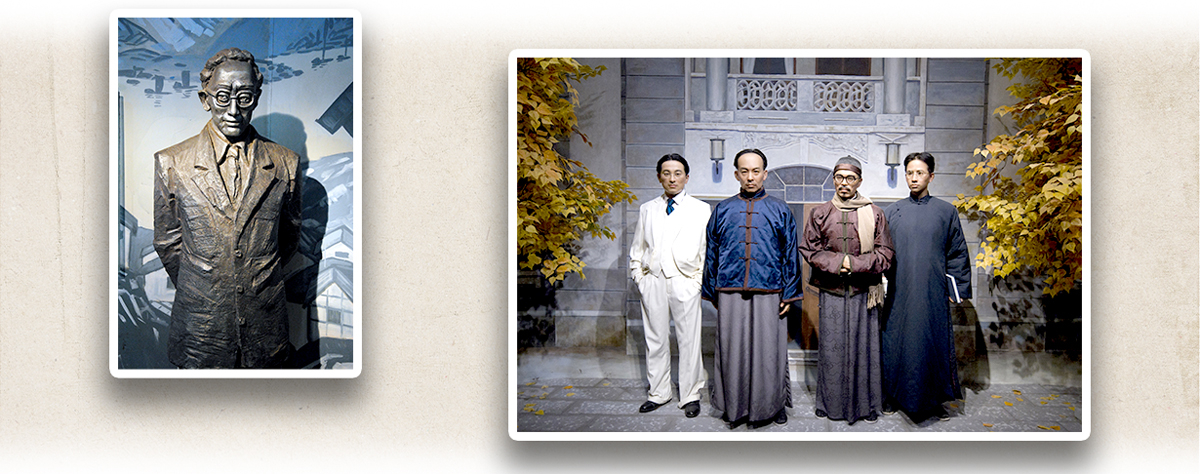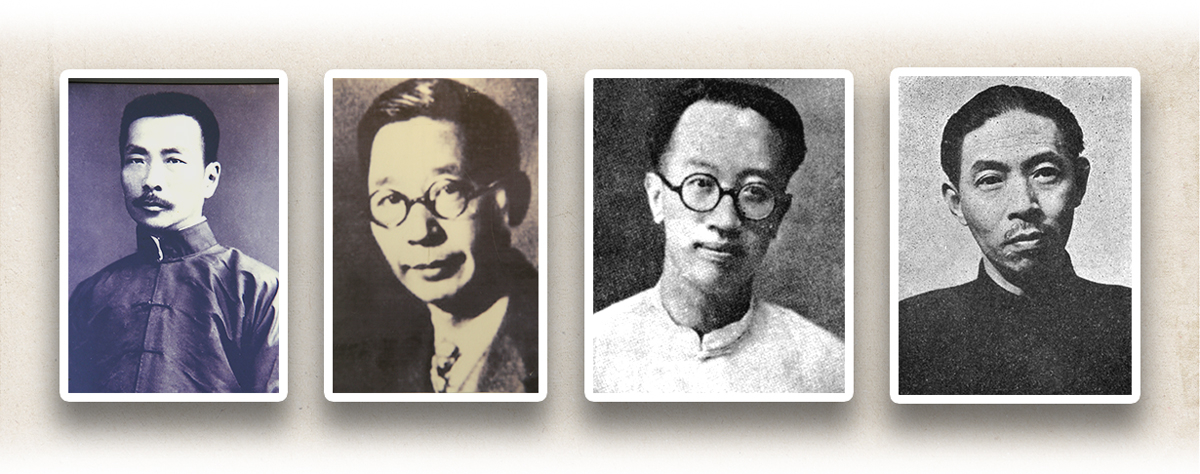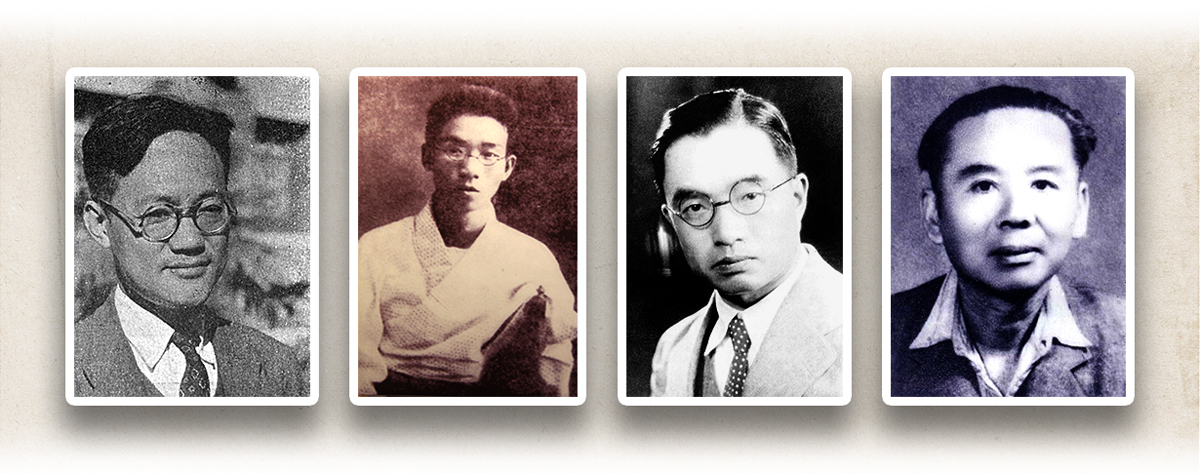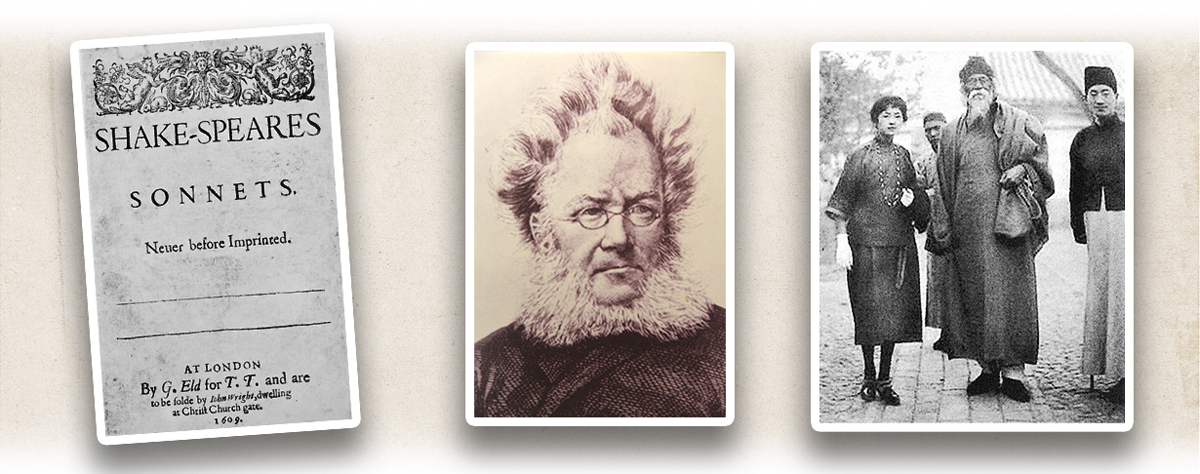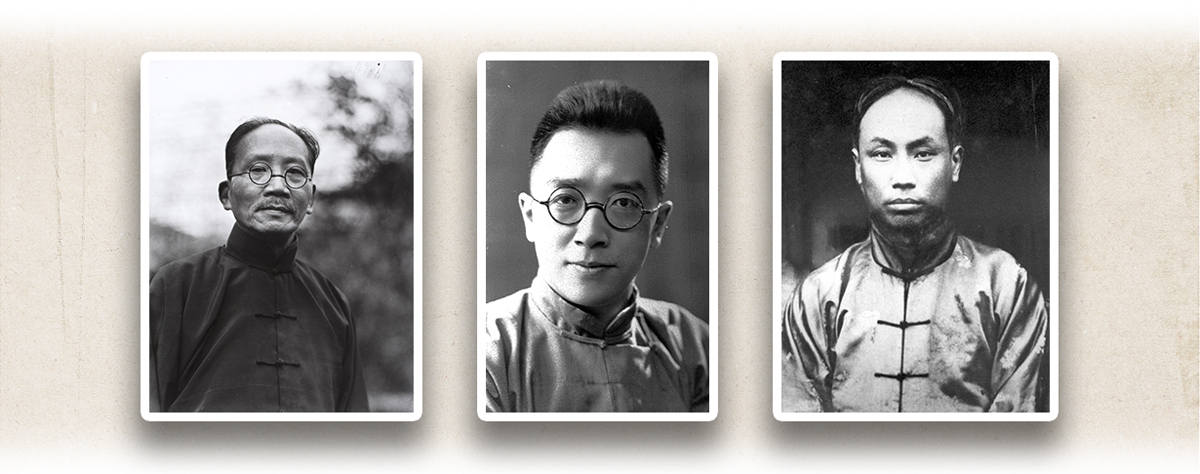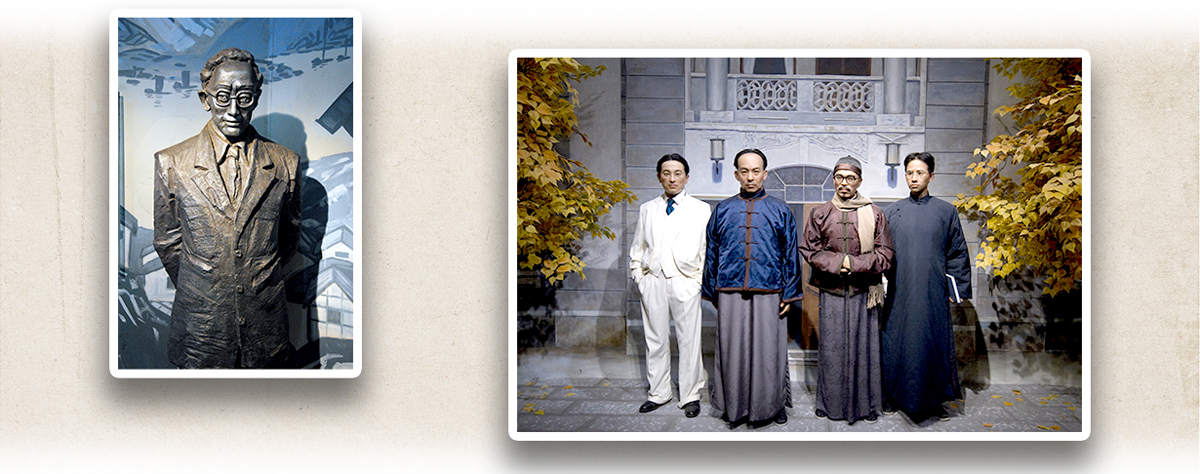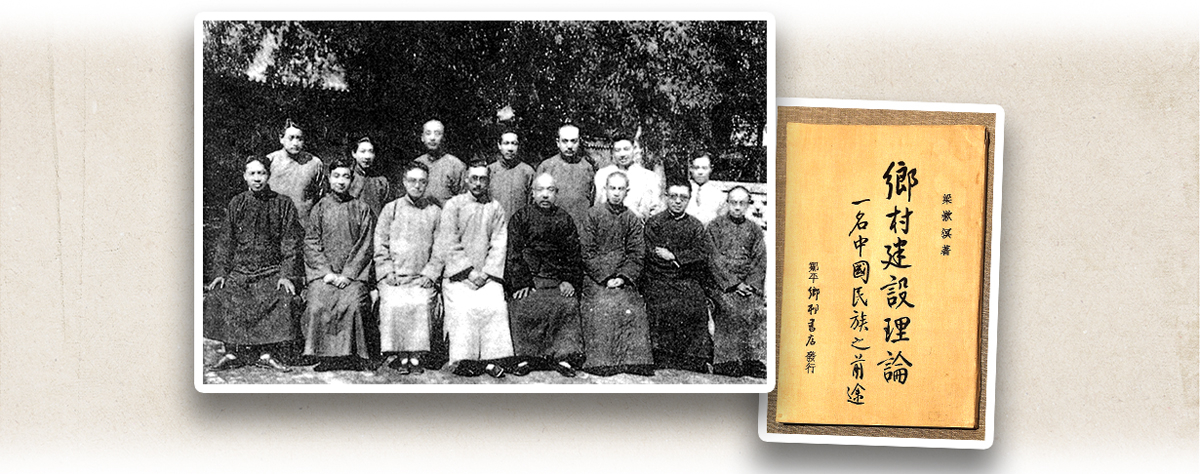Prior to the founding of the People’s Republic of China in 1949, the short years of the Republic of China (ROC) passed amid wars. Despite its short lifespan, the period produced a large number of top scholars, literary masters, and astounding artistic and academic works. There are a great number of famous novels, poems, and articles from the ROC, including Lu Xun’s (魯迅) Kong Yiji (《孔乙己》), The True Story of Ah Q (《阿Q正傳》), and The New Year Sacrifice (《祝福》); Lao She’s (老舍) Four Generations Under One Roof (《四世同堂》) and Rickshaw Boy (《駱駝祥子》); Ba Jin’s (巴金) Family, Spring, and Autumn (《家》、《春》、《秋》); Mao Dun’s (茅盾) Midnight (《子夜》); Bing Xin’s (冰心) To Young Readers (《寄小讀者》); Guo Moruo’s (郭沫若) Drifting Trilogy (《漂流三部曲》) and the new poem Nirvana of the Phoenix (《鳳凰涅槃》); Lin Yutang’s (林語堂) Moment in Peking (《京華煙雲》); Liang Shiqiu’s (梁實秋) Sketches of a Cottager (《雅舍小品》); Zhu Ziqing’s (朱自清) Retreating Figure (《背影》) and Transient Days (《匆匆》); Shen Congwen’s (沈從文) Border Town (《邊城》); Qian Zhongshu’s (錢鍾書) Fortress Besieged (《圍城》); Xiao Qian’s (蕭乾) Valley of Dreams (《夢之谷》); Xiao Hong’s (蕭紅) Tales of Hulan River (《呼蘭河傳》); Xiao Jun’s (蕭軍) Village in August (《八月的鄉村》); Zhang Ailing’s (張愛玲) Love in a Fallen City (《傾城之戀》); Su Xuelin’s (蘇雪林) Green Skies (《綠天》); Xu Zhimo’s (徐志摩) Taking Leave of Cambridge Again (《再別康橋》) and Zhimo’s Poems (《志摩的詩》); Yu Dafu’s (郁達夫) Sinking (《沉淪》); Li Guangtian’s (李廣田) Quesuo Collection (《雀蓑集》); Duanmu Hongliang’s (端木蕻良) The Ke’erqin Banner Grasslands (《科爾沁旗草原》); Ding Ling’s (丁玲) Miss Sophia’s Diary (《莎菲女士的日記》) and The Sun Shines Over Sanggan River (《太陽照在桑乾河上》); Zhou Libo’s (周立波) The Hurricane (《暴風驟雨》); Ai Qing’s (艾青) North (《北方》); Zhao Shuli’s (趙樹理) Little Erhei’s Marriage (《小二黑結婚》) and Change Comes to Li Family Village (《李家莊的變遷》); Bu Naifu ’s (卜乃夫, using the pen name “Anonymous” ) Romance in Siberia (《北極風情畫》) and Lady in the Tower (《塔裏的女人》); Zhang Henshui’s (張恨水) Fate in Tears and Laughter (《啼笑因緣》), and Huanzhulouzhu’s (還珠樓主) Legend of the Swordsmen of the Mountains of Shu (《蜀山劍俠傳》).
In the academic world, freedom, democracy, and science prevailed under the influence of the New Culture Movement. After becoming President of Peking University in 1916, Cai Yuanpei (蔡元培) was determined to reform. Chen Duxiu (陳獨秀), Hu Shi (胡適), and other famous scholars also lectured there, infusing Chinese academia with a new atmosphere. Meanwhile, Wu Mi (吳宓) invited Wang Guowei (王國維), Liang Qichao (梁啟超), Chen Yinke (陳寅恪), and Zhao Yuanren (趙元任) to teach at the Tsinghua Academy of Chinese Learning (a subsidiary of Tsinghua University, 清華學校研究院). Known as the “Four Famous Professors” and the “Four Tutors of Chinese Learning”, the four illustrious scholars’ reputations spread far and wide. Among them, Liang’s influence truly spanned the eras. He left behind an immortal masterpiece titled Collected Works from the Ice-Drinker’s Studio (《飲冰室合集》). Zhao was an expert linguist, making remarkable contributions to phonology and writing. Liang Shuming (梁漱溟) founded the New Confucianism school of thought. Chen Yuan (陳垣) and Tang Yongtong (湯用彤) researched and published masterworks on the history of religions. In addition, Hua Luogeng (華羅庚), Li Siguang (李四光), Qian Xuesen (錢學森), Qian Weichang (錢偉長), Qian Sanqiang (錢三強), Deng Jiaxian (鄧稼先), and Zhao Jiuzhang (趙九章) made remarkable accomplishments in mathematical sciences, significantly contributing to China’s future technological development.
|
|
In a short span of fewer than 40 years, the ROC was faced with domestic turmoil and foreign aggression. How did a multitude of famous scholars and masterpieces arise from these circumstances? |
|
|
See answer below. |
Four renowned writers in the Republican period (from the left): Lu Xun, Lao She, Liang Shiqiu, and Mao Dun.
Four other famous writers in the Republican period (from the left): Ba Jin, Yu Dafu, Zhu Ziqing, and Zhang Henshui.
With the rise of women’s status, the ROC also had a number of women writers. From the left: Bing Xin, Xiao Hong, Zhang Ailing, and Ding Ling.
Writers in this period absorbed elements of foreign literature, uplifting the Chinese literary scene.
Left: a book of sonnets by British playwright and poet William Shakespeare. Shakespeare had an influence on plays and poems during the Republican period. Middle: Norwegian playwright Henrik Johan Ibsen had a significant influence on Republican-period dramas. Right: In 1924, Indian philosopher and poet Rabindranath Tagore visited China. Here he is pictured with Lin Huiyin (林徽因) and Xu Zhimo. Tagore’s poetry and thought were an inspiration to Chinese literature.
Left: the restored scene of Nanjing Pukou Railway Station (南京浦口火車站) where the story described in Zhu Ziqing’s Retreating Figure took place. Right: the stone carving of Taking Leave of Cambridge Again at Xu Zhimo’s tomb. Many classic works of the Republican period are now required readings in Chinese curricula and have continued to inspire Chinese writers. Literature in the ROC has had a profound influence on the cultural and educational development of Chinese communities worldwide.
Many literary works created during the Republican period have had a profound influence on Chinese songwriting, films, and TV series worldwide.
Many literary works in this period, especially novels and plays, have since been adapted into films and TV series. Left: a poster for the 1956 film The Family (《家》), a drama adaptation of Ba Jin’s novel of the same name. Right: a poster for the 1982 film adaptation of Lao She’s Rickshaw Boy.
Some writers’ lives were just as legendary as their works, providing rich materials for films and TV series. The 1988 film Cherry Blossoms (or When Tat Fu Was Young《郁達夫傳奇》), for example, depicted the life of Yu Dafu, who was played by Chow Yun-fat (周潤發). In 1999, the cross-strait work April Rhapsody (《人間四月天》) adapted the story of Xu Zhimo’s romantic life featuring Lin Huiyin, Liang Sicheng (梁思成), and Lu Xiaoman (陸小曼). It had a great reception across Chinese communities.
The impact of Republican-period literature on Chinese music scene cannot be ignored either. Some poems were set to music and became popular songs. For instance, in the 1970s, Taking Leave of Cambridge Again and Chance by Xu Zhimo were set to music, which were composed by Li Datao (李達濤) from Taiwan and Chelsia Chan Chau-ha (陳秋霞) from Hong Kong, respectively. In 1974, a Hong Kong TV station broadcast Zhang Henshui’s novel Fate in Tears and Laughter as a TV play and the theme song as its namesake. The song was composed by Joseph Koo Kar-fai (顧嘉煇) with lyrics by Yip Shiu-tak (葉紹德) and was sung by Sandra Lang (仙杜拉). It is regarded as groundbreaking work in the Hong Kong music world previously dominated by Western and Mandarin songs, helping revitalise Cantonese pop.
The Republican period produced a multitude of scholars and recorded outstanding academic achievements. These had much to do with the open and inclusive atmosphere of Peking University. After becoming President of Peking University in 1916, Cai Yuanpei (left) focused on reforming and Sino-Western integration. Meanwhile, Hu Shi (middle), Chen Duxiu (right), and other famous teachers lectured at Peking University, introducing new perspectives into Chinese academia.
In the 1920s, Dean Wu Mi caused a sensation by inviting Wang Guowei, Liang Qichao, Chen Yinke, and Zhao Yuanren to teach at the Tsinghua Academy of Chinese Learning. They were known at the time as the “Four Famous Professors” or the “Four Tutors of Chinese Learning”. The photos show the statues of Wu Mi (left) and the “Four Tutors of Chinese Learning” (right), namely Zhao Yuanren, Liang Qichao, Wang Guowei, and Chen Yinke from left to right. For a time during the ROC, anti-traditional movements were widespread, traditional fields of Chinese Studies made substantial progress nevertheless. Traditional Confucianism underwent reforms to better keep pace with the times. Representative figures of New Confucianism were Liang Shuming, Xiong Shili (熊十力), and Ma Yifu (馬一浮), who were collectively acclaimed as the “Three Sages of New Confucianism”.
Many academics during the period took an active part in social movements, such as the Rural Construction Movement. Left: participants in the Rural Reconstruction Movement in 1935, with including Liang Shuming (first from right at the front row). Right: A Theory of Rural Reconstruction by Liang, which provided a theoretical reference for the Rural Reconstruction Movement.
In the 1920s-30s, internal and external challenges caused economic depression and mass destitution in rural areas. Liang Shuming, Y. C. James Yen (晏陽初), Huang Yanpei (黃炎培), and other progressive figures actively explored ways to help and support rural areas. Their methods varied from the popularisation of agricultural technologies, to a focus on farmer education, or on local autonomy and the building of political power, or an emphasis on economy, politics, and morality in equal measures. They conducted experiments in some rural locations such as Zouping (鄒平) of Shandong Province (山東), Ding County (定縣) of Hebei Province (河北), and Wuxi (無錫) and Kunshan (崑山) of Jiangsu Province (江蘇). The most famous among these was the Zouping Experiment (鄒平實驗) led by Liang from 1931 to 1937 historically known as the “Rural Reconstruction Movement”. Another Republican-period educator, Tao Xingzhi (陶行知), spent many years promoting mass literacy and education according to the “Integration of Knowledge and Action”, a principle first put forward by Ming dynasty (明代) thinker Wang Yangming (王陽明).
Education was highly valued during the ROC. The period cultivated many prominent figures who were influential to China’s later development in science and technology. From left to right: Qian Xuesen, Qian Weichang, Qian Sanqiang, and Deng Jiaxian.
|
|
In a short span of fewer than 40 years, the ROC was faced with domestic turmoil and foreign aggression. How did a multitude of famous scholars and masterpieces arise from these circumstances? |
|
|
As an old saying goes, “heroes emerge in troubled times”. Looking back at the long history of China, it is observed that when states were divided and at war during the Spring and Autumn Period and the Warring States Period, diplomats were the most active, reforms were the most widespread, and new ideas emerged in short succession, which culminated in the Hundred Schools of Thought. The ROC emerged amid the fall of autocratic monarchy and the rise of the Republic. Meanwhile, China was gripped by sharp social contradictions, infighting among warlords, internal disorder, and external aggression, all together providing rich sources of thought for literary creations and academic research. The volatile circumstances of the times pushed writers to reflect social issues and scholars to think deeply on China’s future path. Meanwhile, it was difficult for leaders to maintain control and enforce decrees amid the chaos, which gave space for much freer speech, thought, and presses. There was thus a myriad of publications and viewpoints beyond the limited official news. The New Culture Movement, for instance, brought both hardline campaigns for the displacement of Confucianism by Westernisation as well as campaigns for the continuation of Confucian ways under New Confucianism. In terms of literature, the ROC produced both serious works contemplating the fate of the country and its people as well as new style martial art novels like Legend of the Swordsmen of the Mountains of Shu. There were romantic fictions classified as Mandarin Duck and Butterfly School. One can say that the chaos in modern China ushered in another “Hundred Schools of Thought”. |
Source of most photos used in this feature piece: Fotoe.




